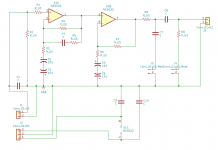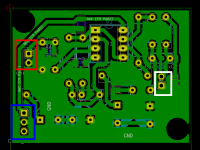I _think_ that the cartridge was connected to a braun csv-500 phono inputYou need to load the cartridge with 50k and a few 100pF before any voltages measured are meaningful - with only a x10 probe as load a cartridge may be strongly resonant at the top end.
mHz is thousands of a hertz! Not sure Tektronix would appreciate their scope being downgraded 9 orders of magnitude there
at the time. The event was 40 years ago but i do clearly remember the
magnitude.
And of course it was a 100Mhz memory scope borrowed from the tek representative, triggered as single-shot and saved on screen.
This discovery made me change to a tube riaa ( quad ) and suddenly the
record collection had much less irritating dust. My explanation at the time was
that a large pop could saturate a transistor, in effect widening the click.
The quad didn't saturate thus the click was much shorter and has much less
energy at the riaa output.
I built a simple passive equalization op-amp based preamp (NE5532AP).
It works fine BUT there's quite a lot of hiss (only noticiable when record is playing low volume or silence passages) and some hum.
I'm powering the preamp using batteries. The PCB is inside a metal box. The only connection of signal ground to chassis is on one of the RCA input jacks.
I attached a PCB layot image (one side):
Power input marked in blue.
Input marked in red.
Output marked in white.
I filled with copper unused areas to get as much ground area as possible to reduce ground tracks resistance.
Is there anything wrong in my design?
It works fine BUT there's quite a lot of hiss (only noticiable when record is playing low volume or silence passages) and some hum.
I'm powering the preamp using batteries. The PCB is inside a metal box. The only connection of signal ground to chassis is on one of the RCA input jacks.
I attached a PCB layot image (one side):
Power input marked in blue.
Input marked in red.
Output marked in white.
I filled with copper unused areas to get as much ground area as possible to reduce ground tracks resistance.
Is there anything wrong in my design?
Attachments
. Quote-
"I'm powering the preamp using batteries. The PCB is inside a metal box. The only connection of signal ground to chassis is on one of the RCA input jacks."
Most of the twin/dual IC RIAA /audio circuits I built were JLH designs or variations none of them isolated the input signal from the rest of the IC design .
I can see that being done in a power amp with a 10 ohm resistor between the input/VAS stage and the heavy output side , can you give me the design strategy in case I am missing/forgetting something ?
I have never in all my years had a JLH design of this sort give off even low level hum /noise and that was using John,s preferred SHUNT feedback which theoretically is inferior to the normal circuit design in noise ( but superior in definition/detail).
"I'm powering the preamp using batteries. The PCB is inside a metal box. The only connection of signal ground to chassis is on one of the RCA input jacks."
Most of the twin/dual IC RIAA /audio circuits I built were JLH designs or variations none of them isolated the input signal from the rest of the IC design .
I can see that being done in a power amp with a 10 ohm resistor between the input/VAS stage and the heavy output side , can you give me the design strategy in case I am missing/forgetting something ?
I have never in all my years had a JLH design of this sort give off even low level hum /noise and that was using John,s preferred SHUNT feedback which theoretically is inferior to the normal circuit design in noise ( but superior in definition/detail).
Most of the twin/dual IC RIAA /audio circuits I built were JLH designs or variations none of them isolated the input signal from the rest of the IC design
Maybe I didn't get you right, but I'm not isolating the input signal from the rest of the circuit. The signal ground connects input, output, NFB caps and power input in the PCB (just in case, forget about J3/J4, as they are jumpers, and are shorted).
It is just that I make a single connection to the chassis, at one of the RCA connectors. Did you do the same on your builds?
Thanks for your answer Elerion okay yes in a PREAMP IC design like this I connected the earths to a common at the input earth.
It has occurred to me as you are using a battery supply that the noise could be coming from them .
Nicad have the lowest noise ,alkaline batteries have higher noise levels , even a battery at at lower voltage than the others can create noise .
Try putting a 1uf capacitor across the batteries ( no higher ) to see if it makes any difference.
It has occurred to me as you are using a battery supply that the noise could be coming from them .
Nicad have the lowest noise ,alkaline batteries have higher noise levels , even a battery at at lower voltage than the others can create noise .
Try putting a 1uf capacitor across the batteries ( no higher ) to see if it makes any difference.
Last edited:
Just an update, for if someone gets here in a future.
The circuit became much more quite after properly grounding the phono's unused channel (I was testing a single channel at a time, leaving the other phono's RCA cable floating). It is perfectly usable now.
Any input, particularly phono inputs, if left "wide open" are prone to creating noise.
Shorting them is the logical answer, and has been already done for decades with commercial/consumer equipment.
- Status
- This old topic is closed. If you want to reopen this topic, contact a moderator using the "Report Post" button.
- Home
- Source & Line
- Analogue Source
- Basic question, output level from cartridge

